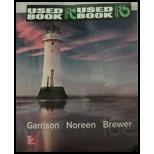
EXERCISE 12A-6 Value-Based Pricing; Absorption Costing Approach to Cost-Plus Pricing LO12-8, LO12-10
Valmont Company has developed a new industrial piece of equipment called the XP-200. The company is considering two methods of establishing a selling price for the XP-200-absorption cost-plus pricing and value-based pricing.
Valmont’s cost accounting system reports an absorption unit product cost for XP-200 of $8,400. Its markup percentage on absorption cost is 85%. The company's marketing managers have expressed concerns about the use of absorption cost-plus pricing because it seems to overlook the fact that the XP-200 offers superior performance relative to the comparable piece of equipment sold by Valmont's primary competitor. More specifically the XP-200 can be used for 20,000 hours before replacement. It only requires $1,000 of preventive maintenance during its useful life and it consumes $120 of electricity’ per 1,000 hours used.
These figures compare favorably to the competing piece of equipment that sells for $15,000: needs to be replaced after 10,000 hours of use, requires $2,000 of preventive maintenance during its useful life and comes $140 of electricity per 1,000 hours used.
Required:
- If Valmont uses absorption cost-plus pricing; what price will it establish for the XP-200?
- What is XP-200's economic value to the customer (EVC) over its 20:000-hour life?
- If Valmont uses value-based pricing, what range of possible prices should it consider when setting a price for the XP-200?
- What advice would you give Valmont's managers when choosing between absorption cost-plus pricing and value-based pricing?
Trending nowThis is a popular solution!

Chapter 12 Solutions
Managerial Accounting
- Problem No. 2 The trial balance of Cleint Lumanao Nacho Supplies on February 10, 2025, before accepting Shila Tajonera as partner is shown as follows: Account Title Debit Credit Ato Cash reening smuo P 100,000 Accounts Receivable 250,000 Allowance for Uncollectible Accounts P 20,000 o Merchandise Inventory Equipment Accumulated Depreciation Accounts Payable Notes Payable 120,000 275,000 55,000 50,000 82,000 538,000 Lumanao, Capital Total P 745,000 P 745,000 Tajonera offered to invest cash to get a capital credit equal to one-half of Lumanao's capital after giving effect to the adjustments below. Lumanao accepted the offer. Valuation of some of the assets and liabilities of Lumanao, as agreed by the partners, are the following: • The merchandise is to be valued at P93,000. The accounts receivable is estimated to be 90% collectible. • The equipment is to be valued at P200,000. The partners also agreed that the name of the partnership will be Nacho Business. Required: 1. In the books of…arrow_forwardIf data is unclear in image or image blurr then comment.arrow_forwardSolve correctly without using aiarrow_forward
- Give solution correctly no chatgptarrow_forwardProblem No. 1 On January 1, 2025, Manuel Cruz and Sherimae Diasalo agreed to form a partnership that will manufacture and sell biscuits. The partnership agreement specified that Cruz is to invest cash of P1,000,000 and Diasalo is to contribute land and building to serve as the office and factory of the business. The following amounts are applicable to the property of Diasalo: Acquisition Cost Fair Market Value Land Building P1,000,000 500,000 P1,500,000 850,000 During the formation, it was found out that Cruz has accounts receivable amounting to P70,000 and the partners agreed that it will be assumed by the partnership. The name of the partnership will be Fita Pan. Required: 1. Prepare journal entry to record: a. The investment of Cruz to the partnership b. The investment of Diasalo to the partnershipood relay ni 000,219 2. Prepare the statement of financial position of the partnership as of January 1, 2025 Problem No. 2 The trial balance of Cleint Lumanao Nacho Supplies on February…arrow_forwardA company's stock price is $80, with earnings per share (EPS) of $10 and an expected growth rate of 12%.arrow_forward
- Kazama owns JKL Corporation stock with a basis of $20,000. He exchanges this for $24,000 of STU stock and $8,000 of STU securities as part of a tax-free reorganization. What is Kazama's basis in the STU stock?arrow_forwardKensington Textiles, Inc. manufactures customized tablecloths. An experienced worker can sew and embroider 10 tablecloths per hour. Due to the repetitive nature of the work, employees take a 10-minute break after every 10 tablecloths. Additionally, before starting each batch of 10 tablecloths, workers spend 8 minutes cleaning and setting up their sewing machines. Calculate the standard quantity of direct labor for one tablecloth.arrow_forwardSolvearrow_forward
- Problem: The bank statement balance of $7,000 does not include a check outstanding of $1,000, a deposit in transit of $275, and another company's $250 check erroneously charged against your firm's account. The reconciled bank balance is__?arrow_forwardGiven step by step explanation general accounting questionarrow_forwardQuick answer of this accounting questionsarrow_forward
 Managerial AccountingAccountingISBN:9781337912020Author:Carl Warren, Ph.d. Cma William B. TaylerPublisher:South-Western College Pub
Managerial AccountingAccountingISBN:9781337912020Author:Carl Warren, Ph.d. Cma William B. TaylerPublisher:South-Western College Pub Survey of Accounting (Accounting I)AccountingISBN:9781305961883Author:Carl WarrenPublisher:Cengage Learning
Survey of Accounting (Accounting I)AccountingISBN:9781305961883Author:Carl WarrenPublisher:Cengage Learning

